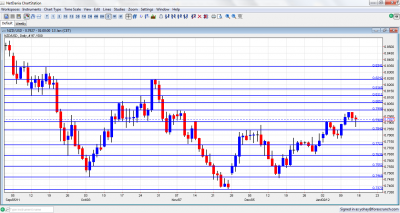The kiwi pushed higher and even managed to weather the European storm. Will this strength continue? NZIER Business Confidence and inflation rate are the major events this week. Here’s an outlook for the events in New Zealand, and an updated technical analysis for NZD/USD
Weak readings were released in the last 7 days with a widening trade balance deficit of NZ$308 million, building consents dropping 6.4% after 10.7% rise in September and ANZ Commodity Prices continuing to decline by 0.8%. Let’s see what this week has in store for us. Despite a fall in Australian employment numbers, the European optimism sent the kiwi up as well.
Updates: NZD/USD slipped at the wake of the new week, but it is still holding on to the 0.79 line. The kiwi dollar enjoyed the strong Chinese GDP (8.9%) and temporarily managed to rise above the 0.80 line. This didn’t hold though. The kiwi is pushing higher and challenging the 0.8060 line ahead of the quarterly CPI release. See how to trade this event with NZD/USD.
NZD/USD daily chart with support and resistance lines on it. Click to enlarge:
- FPI: Sunday, 21:45. New Zealand food prices increase by 0.2% following 1.3% decrease in the previous month. This is the first climb in four months driven by higher meat and grocery prices.
- REINZ HPI: Mon-Tue. The REINZ Housing Price Index climbed 1.1% in November amid increases in major markets. Compared to November 2010 the REINZ Housing Price Index increased 2.6%. October’s reading showed a 0.3% decline.
- NZIER Business Confidence: Monday, 21:00. The New Zealand Institute of Economic Research (NZIER) released its quarterly figures for the Aug-Oct period revealing a 2% drop to 25 from the previous quarter indicating a slowdown in economic activity.
- Inflation data: Wednesday, 21:45. New Zealand inflation increased by 0.4% in the third quarter lower than the 0.7% expected by analysts. The rise was driven by food, housing and utilities prices. However this moderate climb is expected to shoot up in the next months. CPI is expected to rise by 0.4%.
* All times are GMT.
NZD/USD Technical Analysis
Kiwi/dollar kicked off the week with a run upwards. After securing the 0.79 line (mentioned last week), it traded between this line and the round 0.80 figure most of the time. A drop under this line was only temporary.
Technical lines, from top to bottom:
We start from higher ground this time: 0.8340 was a peak in September and is minor resistance. 0.8240 was a peak in October and also back in May 2011.
It is followed by 0.8165 provided support for the pair at several occasions, last seen in October. 0.8110 switched positions from support in August to resistance later on and is a minor line on the way up.
0.8060 was resistance in October and support beforehand. The round number of 0.80 managed to cap the pair in November and remains of high importance, especially due to its psychological importance.
Another round number, 0.79, is now stronger resistance after capping a rise at the beginning of 2012. 0.7840 worked as cap for a range and earlier stopped the pair in October. It then became much stronger in December, holding the range. The pair approached in the last days of 2011, but couldn’t really challenge it.
0.7773 was the bottom border of a range at the beginning of 2012, and also in December. 0.77 provided support in December and is now minor support. 0.7637 was a swing low in September and provided its strength in December as a swing low. It is a still strong, after capping a recovery attempt in December.
0.7550 now has a stronger role after working as a very distinct line separating ranges. It had a similar role back in January. 0.7470 was the trough in October and worked as perfect support in December.
I am neutral on NZD/USD
On one hand, demand for food remains steady, and the talk of more QE in the US helps the kiwi. On the other hand, the landing in China, together with worsening crisis in Europe, weighs on the kiwi.
Further reading:
- For a broad view of all the week’s major events worldwide, read the USD outlook.
- For EUR/USD, check out the Euro to Dollar forecast.
- For the Japanese yen, read the USD/JPY forecast.
- For GBP/USD (cable), look into the British Pound forecast.
- For the Australian dollar (Aussie), check out the AUD to USD forecast.
- For USD/CAD (loonie), check out the Canadian dollar
- For the Swiss Franc, see the USD/CHF forecast.
